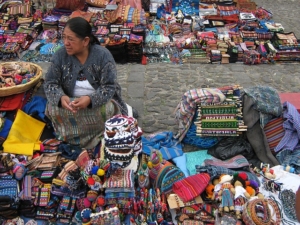Poverty Is a Greater Problem Than Illiteracy Art Poverty Art

Republic of guatemala is a country fabricated upwardly of half-dozen master ethnic communities, though the population mostly comprises people belonging to the Mestizo and Maya ethnic groups. These ethnic groups are generationally skilled in creating traditional forms of art, which include weaving, beading and embroidering. More than one-half the Guatemalan population lives in a highly populated southern mountainous area. Within this region also live the majority of communities that experience poverty in the country. Many individuals from ethnic communities in this region use art to leverage themselves out of poverty in Guatemala.
Poverty in Guatemala
While Guatemala'south GDP has increased by an average of 3.5% over the past v years, high rates of poverty yet exist within the country. Almost 59.3% of the Guatemalan population (9.4 million people) alive below the poverty line. In surrounding Latin American and Caribbean (LAC) regional contexts, the average per capita growth is ane.6%. Due to high population growth rates since 2000, Guatemala'southward recent almanac per capita growth is merely one.3%. High population growth rates are, in part, acquired by a immature population, with a median historic period of 23.ii years.
The Literacy Gap
Guatemala also experiences lower rates of literacy among women than men. Equally of 2018, 85.3% of men and 76.7% of women were literate in Guatemala. Between 2002 and 2014, literacy rates amongst women improved by thirteen.03%. In contempo years, organizations like MayaWorks have worked to accost the low literacy rates among women in Guatemala. MayaWorks is a nonprofit organization that partners with women from rural communities to transform artisanal skills into sustainable businesses. Across 125 partnerships that MayaWorks has established with skilled Guatemalan artisans, more than than 40% of women have never received a principal educational activity — and therefore lack literacy skills. Through one program, MayaWorks offers women in rural Guatemala access to primary education to improve their literacy. Business and literacy grooming programs enable women to non only amend situations for their families and communities merely also to subtract overall rates of poverty in Republic of guatemala.
Supporting Women's Didactics and Entrepreneurship
MayaWorks has shared stories of how business and literacy preparation programs can relieve women suffering from poverty in Guatemala. The Tz'utujil ethnic grouping makes up xxx% of the Maya ethnic population and is primarily in a rural highland region of Guatemala. Women from this ethnic group are skilled in creating Maya-manner crafts, including cultural staples such as crochet, mitt weaving and treadle foot loom weaving. With the help of MayaWorks, more than 52 Tz'utujil women from Santiago Atitlán are leveraging their artisan skills and sharing their cultural forms of expression with businesses in the United States. These partnerships allow for extended solutions to both local and national poverty in Republic of guatemala through international support. Meanwhile, the international business of Mayan artists is strengthening relations between Republic of guatemala and the The states.
The piece of work of Mayan artisans, combined with the financial and educational support of MayaWorks, has already begun to convalesce poverty in Republic of guatemala. Overall literacy levels for Guatemalan women take increased, which has as well led to the employment of more women inside the country'southward workforce. Co-ordinate to the Earth Bank, employment rates for women in Republic of guatemala have reduced from 45.6% in 2000 to 37.84% in 2019. On a localized level, while many women are now able to obtain security for their families and communities, in that location are notwithstanding challenges for women to gain employment. However, MayaWorks promises to help Guatemalan women become successful. Above all, working with MayaWorks equips women to be self-sufficient in running businesses and managing finances. This results in a generationally sustainable, long-term solution for reducing poverty in Guatemala.
– Lilia Wilson
Photograph: Pixabay
lasterwastold1981.blogspot.com
Source: https://borgenproject.org/reduce-poverty-in-guatemala/
0 Response to "Poverty Is a Greater Problem Than Illiteracy Art Poverty Art"
Post a Comment